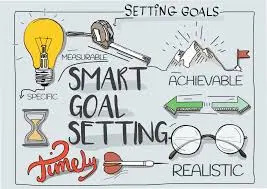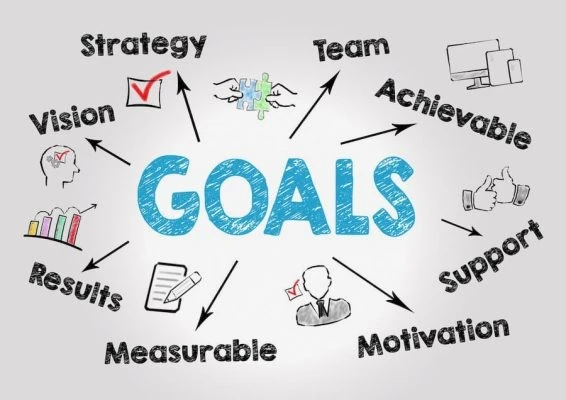Goal Setting
Definition and Purpose
Goal setting involves defining clear, measurable objectives. These objectives guide actions, providing direction and motivation. Goals help individuals and organizations focus on specific outcomes, ensuring purposeful progress.
Importance of Goal Setting for Personal and executive Development
Setting goals enhances personal growth and professional success. By identifying targets, individuals can align their actions, make informed decisions, and measure progress. Goal setting fosters self-discipline, drives achievement, and boosts confidence.
Historical Background
Development of Goal-Setting Theories
Goal-setting theory has evolved through research and practical application. Pioneered in the 1960s, the theory emphasizes the importance of setting challenging, specific goals to improve performance. Early studies identified a direct relationship between goal difficulty and achievement.
“Major Contributions by Edwin Locke and Gary Latham”
Edwin Locke and Gary Latham are the foremost contributors to goal-setting theory. Their research highlights how specific, challenging goals lead to higher performance. They also emphasize the role of feedback and commitment in achieving goals.
Integration of Aristotle’s Final Causality
The concept of final causality, introduced by Aristotle, complements modern goal-setting theory. It asserts that everything has a purpose, much like goals drive human behavior. This idea underscores the importance of setting purposeful goals that align with one’s ultimate objectives.
See also: Chart Your Future: The Essential Guide to Dream Planning

Core Principles of Effective Goal Setting
The SMART framework is crucial for effective goal setting, especially when integrated with OKR software. It ensures goals are clear, trackable, realistic, aligned with broader objectives, and time-sensitive. Specific goals define what needs to be done, while measurable criteria enabled by OKR software allow for progress tracking. Achievable goals are realistic given resources, relevant goals align with larger aspirations, and time-bound goals have deadlines. Utilizing OKR software can streamline the process, making it easier to set, monitor, and achieve SMART goals efficiently.
Temporal Motivation Theory (TMT)
Temporal Motivation Theory (TMT) suggests that time influences motivation. According to TMT, as deadlines approach, motivating force. This theory supports the importance of setting time-bound goals. It also explains why procrastination occurs when deadlines are distant.
Goal Difficulty and Performance Relationship
There is a direct correlation between goal difficulty and performance. Challenging goals push individuals to exert more effort and demonstrate higher commitment. However, goals should be realistic to avoid frustration and disengagement.

The Goal-Setting Process
Identifying and Defining Clear Goals
The first step in goal setting is to diagnose what you want to achieve. Clear, specific goals provide direction and make it easier to measure progress. Define goals in concrete terms, avoiding vague or broad objectives.
Breaking Down Goals into Sub-Goals
Large goals can be overwhelming. Dividing them into smaller, manageable steps makes the task less overwhelming. Sub-goals act as milestones, offering opportunities to celebrate progress and maintain momentum.
Establishing Deadlines and Milestones
Deadlines are crucial for maintaining focus and urgency. Establishing milestones helps track progress and provides motivation. Each milestone achieved builds confidence and keeps you on track toward the final goal.
See also: Future Dreams: Unlocking Your Vision for Tomorrow
Types of Goals
Short-term vs. Long-term Goals
Short-term goals are immediate, achievable within days or weeks. They often serve as steps toward long-term goals, which span months or years. Balancing short-term and long-term goals ensures stable progress.
Performance vs. Learning Goals
Performance goals focus on achieving specific outcomes, such as hitting a sales target. Learning goals emphasize acquiring new skills or knowledge. Both types are important, depending on the context and desired outcome.
Superordinate Goals (Hierarchy of Goals)
Superordinate goals are overarching, long-term objectives that guide other goals. They provide a sense of purpose and align individual efforts with broader aspirations. For example, improving public health could be a superordinate goal for a healthcare organization.
Psychological Aspects of Goal Setting
Goal Commitment and Acceptance
Commitment to a goal is crucial for success. Individuals must accept and internalize goals for them to be effective. This commitment increases motivation and determination, even in the face of challenges.
Role of Self-Efficacy
Self-efficacy, or belief in one’s ability to achieve a goal, plays a vital role in goal setting. Higher self-efficacy leads to greater effort and Determination. It also influences how challenges are perceived and overcome.
Influence of Feedback and Adjustments
Feedback is essential for effective goal setting. It provides information on progress and areas needing improvement. Adjusting goals based on feedback ensures they remain relevant and achievable.
Goal Setting in Different Contexts
Personal Life (Time Management, Life Goals)
In personal life, goal setting can improve time management, health, relationships, and financial stability. Clear goals help classify activities, reduce stress, and enhance overall well-being.
Education (Academic Performance, Achievement Gaps)
In education, goal setting enhances academic performance. Students who set clear goals are more likely to achieve higher grades and bridge achievement gaps. It also encourages continuous learning and self-improvement.
Workplaces (Employee Motivation, Training, Work-Life Balance)
In workplaces, goal setting drives employee motivation and productivity. It helps organize individual performance with organizational objectives. Training goals enhance skills, while work-life balance goals promote well-being.
Sports and Fitness (Performance, Motivation)
Athletes use goal setting to improve performance and maintain motivating force. Specific, goals track progress and set standards for success. traget setting also supports long-term athletic development.
Tools and Techniques for Goal Achievement
Use of Reflection Diaries and Journaling
Journaling helps track progress, reflect on achievements, and identify areas for improvement. Reflection diaries provide insights into the emotional and psychological aspects of traget pursuit.
Visualization and Mental Simulation
Visualization techniques involve imagining the successful achievement of a goal. This mental rehearsal strengthens motivation, clarifies objectives, and enhances performance.
Role of Accountability and Social Support
Accountability increases the likelihood of achieving goals. Sharing goals with others or working with an accountability partner fosters commitment. Social support provides encouragement and resources.
Challenges and Limitations
Misalignment between Goals and Actions
A common challenge is the misalignment between goals and actions. When daily activities do not support goals, progress stalls. Regular evaluation ensures alignment and necessary adjustments.
Overemphasis on Achievement (Unethical Behavior, Tunnel Vision)
An excessive focus on achieving goals can lead to unethical behavior or tunnel vision. It is important to balance ambition with integrity and consider the broader impact of your actions.
Managing Complex and Conflicting Goals
Juggling multiple goals can lead to conflict and stress. Prioritization and strategic planning are essential for managing complex traget structures. Clear communication and compromise help resolve conflicts.
Conclusion
The Impact of Effective Goal Setting on Success
Effective goal setting is a powerful tool for achieving success. It provides direction, fosters motivation, and facilitates continuous improvement.
Continuous Evaluation and Adaptation of Goals
Regularly evaluate goals to ensure they remain relevant and achievable. Adaptation is key to navigating changing circumstances and maintaining progress.
Long-Term Benefits of Goal-Oriented Living
Living a traget-oriented life leads to long-term benefits, including personal growth, professional success, and a sense of fulfillment. The practice of traget setting becomes a foundation for a purposeful and successful life.

